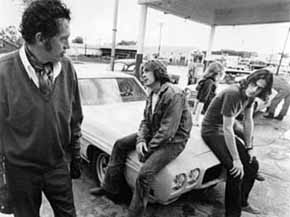|
|
Sole Criterion: Two-Lane BlacktopBy Brett Ballard-BeachMarch 1, 2012
Two-Lane Blacktop stands as a monument for all the films that have been ridiculously overhyped prior to their unveiling and had to simply exist in the flow of time for years or decades in order to finally be "seen." The screenplay was published in advance as an Esquire magazine cover story. A making of feature appeared in Rolling Stone the fall before the film debuted. It was hailed prior to its release as the most important film of the year and an instant classic, and all those other classifications that merely serve to obscure whatever interesting might actually be there to observe underneath the blanket of buzz. Critics and audiences collectively shrugged. The head of the studio deeply regretted the nearly $1 million accorded for its budget. In his brief notes introducing a copy of the 1970 first draft screenplay (by Rudolph “Rudy” Wurlitzer, based on a story and earlier script by Will Corry who also receives credit) that accompanies the Criterion release of Two-Lane Blacktop, director Monte Hellman explains that the script was filmed nearly as written, in its entirety, resulting in a rough cut that clocked in at around 210 minutes. This was more than slightly halved, by Hellman who worked as his own editor, to 103 minutes, in order to retain right of final cut, which he would have given up at any length of over two hours. At the risk of evincing some naïveté, I am willing to take Hellman at his word. In reading the screenplay immediately after watching the film, it felt as if almost every scene included in the film (with one exception being the particular moment I am going to discuss) I encountered in roughly the same form. Wurlitzer’s poetic evocation of scenes and setting are in many cases as important as the dialogue of the characters or the shape the narrative takes, or ends up not taking, by the time the film reaches its definitive ending. If I were to attempt a feeble summation of what Wurlitzer achieves, it would be to find poetry in the lives of people lacking poetry, or leastways, the ability to express themselves outside of a single self-designated role. The only imposition by Hellman on Wurlitzer was in regards to how to end the film - the final two scenes were at his request. And now, I will attempt to work my way through a cinematic variation of my collegiate “reading log”.
|

|
|
|

|
Friday, November 1, 2024
© 2024 Box Office Prophets, a division of One Of Us, Inc.


